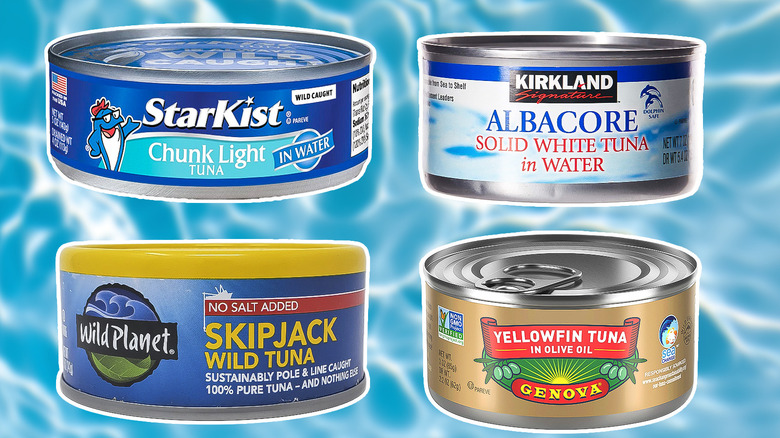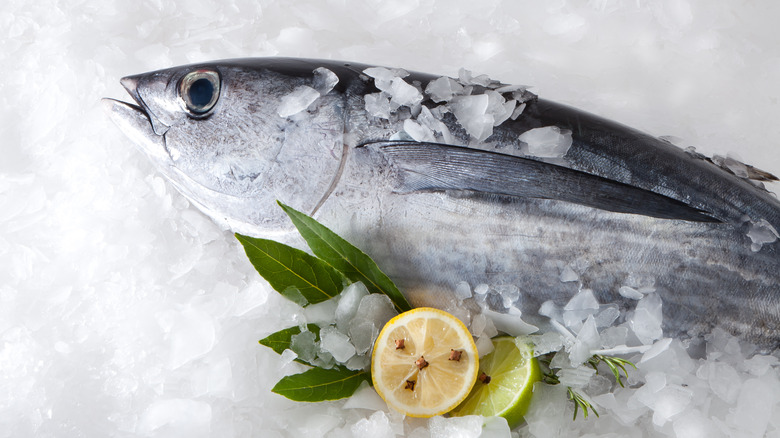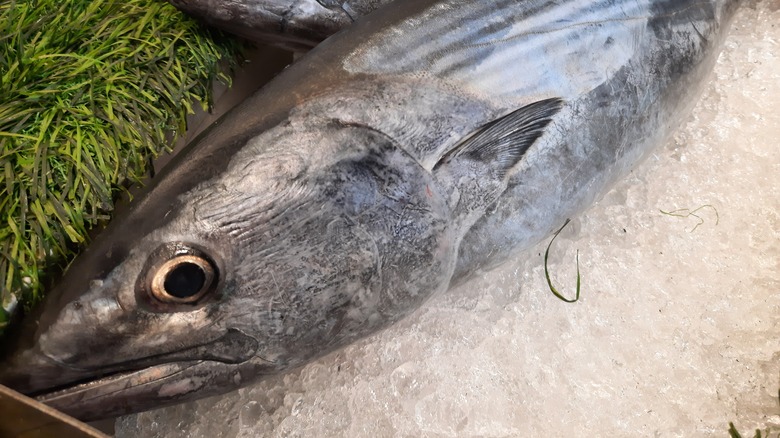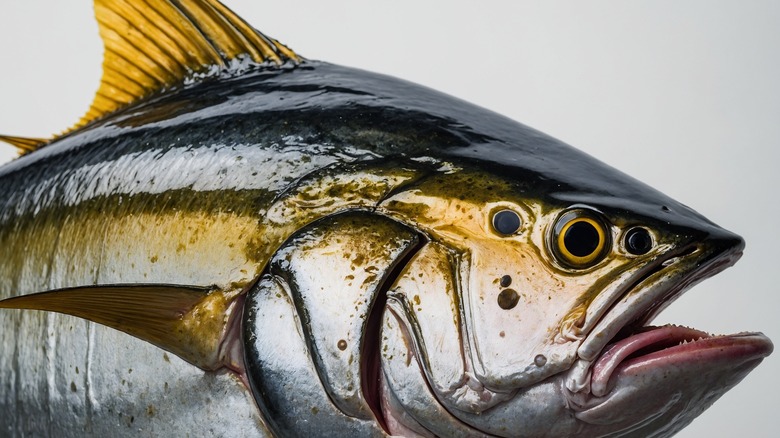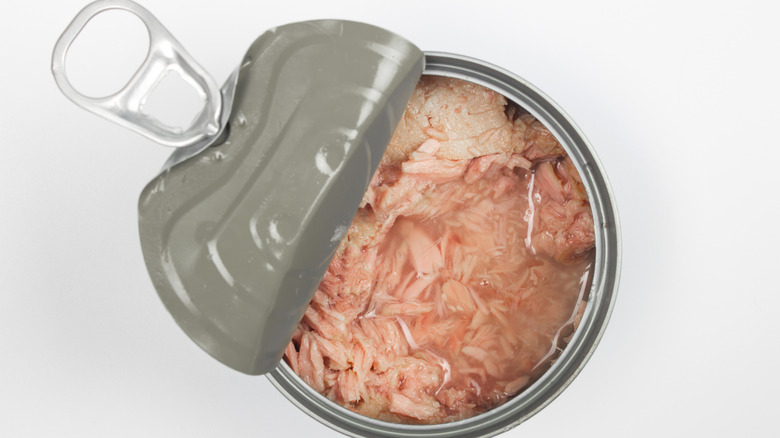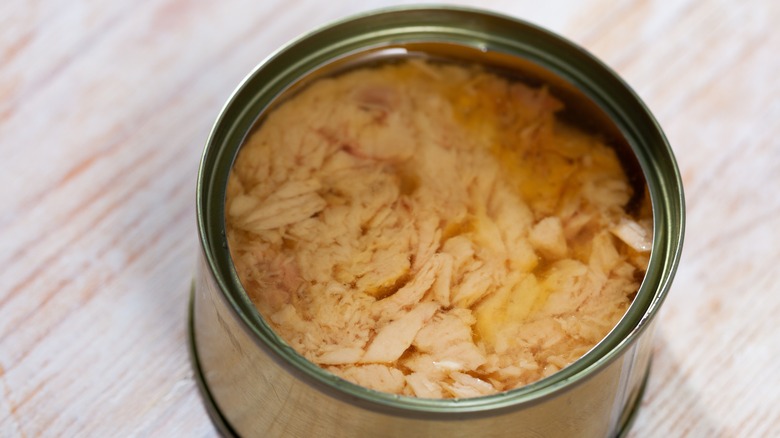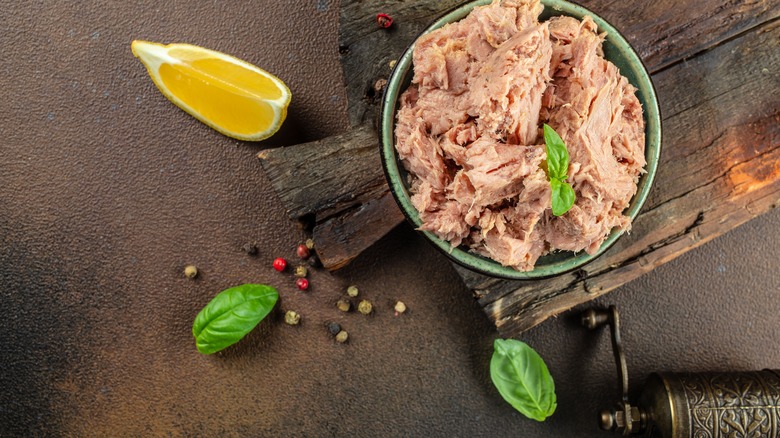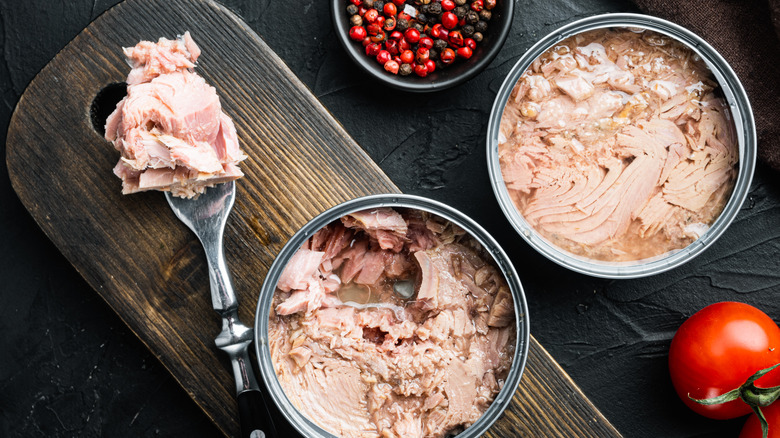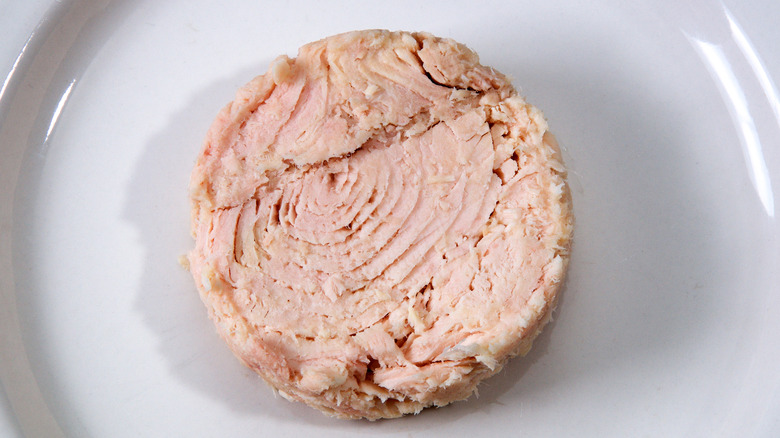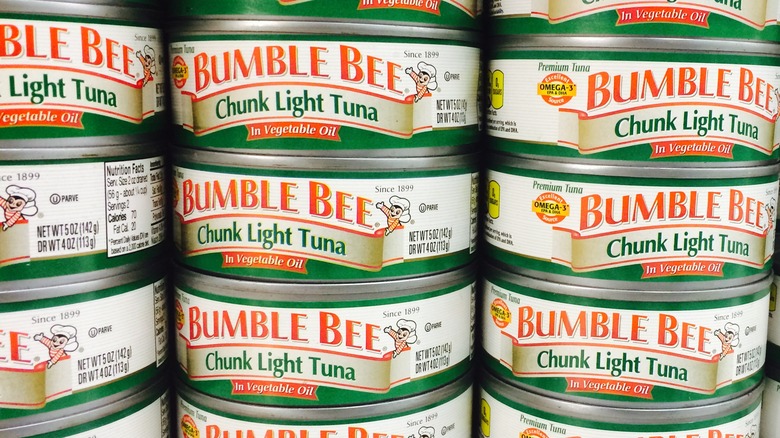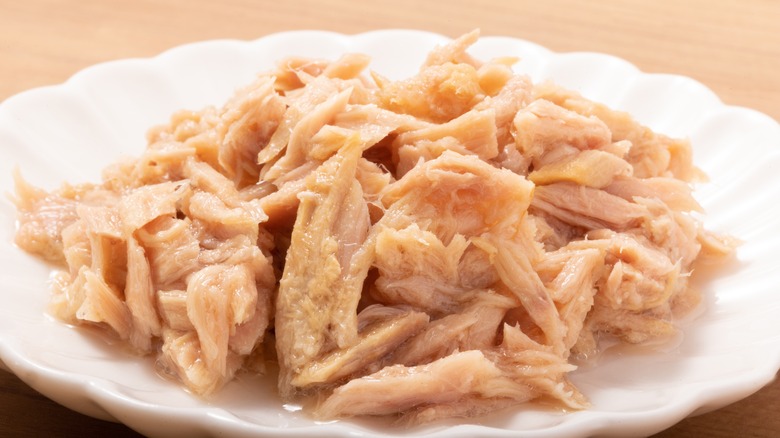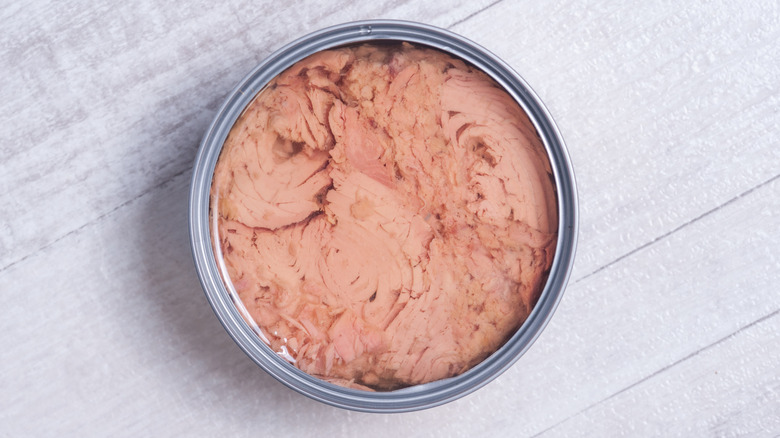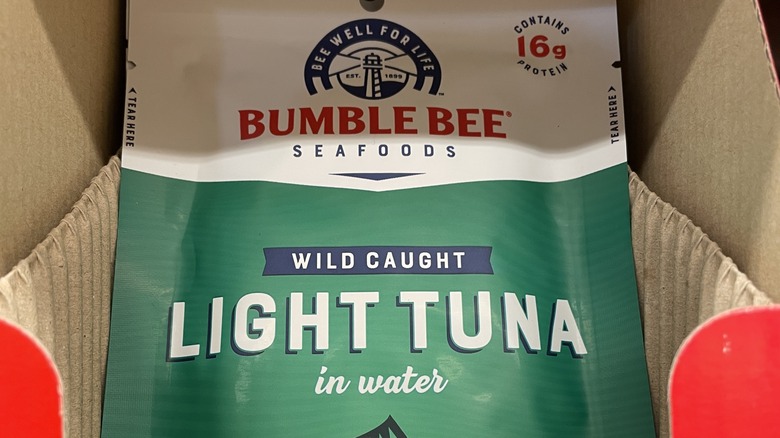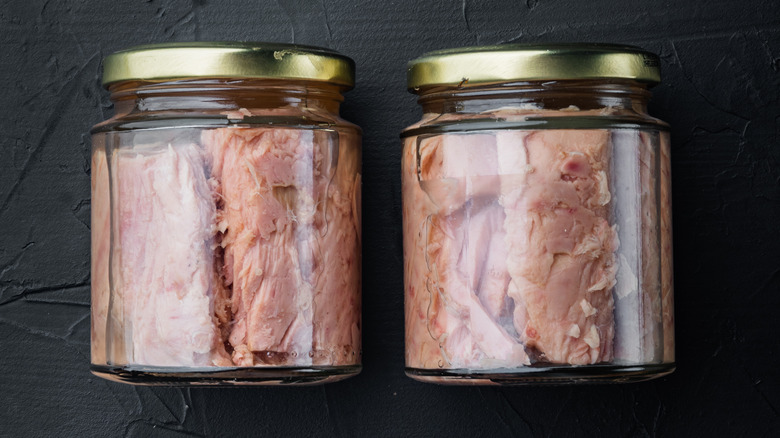The Ultimate Guide To Types Of Canned Tuna
Canned tuna is a classic pantry staple that can often come to the rescue when you need a midweek dinner idea at the last minute. With a long shelf life and virtually no preparation needed, it is always worth having a couple of cans in the cupboard as a standby. You may have noticed, however, that the canned tuna section in the grocery store is getting bigger, and choosing a can of tuna is not the straightforward task it used to be. From choosing between albacore and skipjack, to deciding whether to even buy it in a can, there is a seemingly endless list of options to consider.
In this article, we'll guide you through the many different decisions you may have to consider for canned tuna, from the liquid it is packed in to the size of the tuna pieces in the can. Whether you are buying tuna to make a simple lunch or a sophisticated Niçoise salad, you will soon know which option to choose. So, grab your can opener and join us as we explore the delightful world of canned tuna.
Albacore (white tuna)
If you are after the best variety of canned tuna, both in terms of flavor and ethics, albacore should be your first choice. Often referred to as white tuna – and the only variety that is allowed to be labeled as such – albacore doesn't have an overly "fishy" flavor, so can be enjoyed even by those who are not crazy about other types of tuna. According to the National Oceanic and Atmospheric Administration, albacore is a sustainable fish that is not in danger of being overfished, meaning you can be reassured you are making a good moral choice, too.
Albacore tuna has a firm texture, making it ideal for dishes where you want the fish to keep its shape. It can be added to salads alongside avocado for a protein boost, creating a delicious, healthy meal that only takes minutes to make. Albacore tuna has more omega-3 fatty acids than any other in the tuna family, meaning you can pack those nutritious fats into your meals easily. Although albacore tuna tends to be more expensive than its counterparts, the difference is apparent in its flavor, texture, and sustainability. If you can afford to spend a little more, you won't regret it.
Skipjack
If you were asked to name a type of tuna, there is a good chance that skipjack would be the first to spring to mind. It is the most commonly caught tuna variety on the planet, per Sea Choice. While not as premium as albacore, it is a versatile fish that has that distinctive tuna flavor that many of us know and love.
The texture and flavor of skipjack is noticeably different from that of albacore, with a softer flesh and a much stronger taste that makes it stand out in dishes such as tuna pasta or a tuna sandwich. It is often mixed with mayonnaise which can mask the flavor slightly if you feel it is a little too bold.
Skipjack tuna is considered by the NOAA to be a sustainable option, with no threat of overfishing. It is also a dolphin friendly option, as the mammals do not tend to swim with skipjacks the way they do with other tuna such as yellowfin. Though skipjack comes in behind albacore in terms of heart-healthy omega-3s, it still has enough to make it a good source of this nutritious fat. If you eat canned tuna regularly, you should probably have a few cans of skipjack in the cupboard for whipping up a quick snack or light lunch. It is widely available, inexpensive, and provides a tasty, healthy option for the whole family.
Yellowfin
If you have ever ordered ahi tuna in your local sushi restaurant, you may not have been aware that you were eating yellowfin tuna. Ahi is the Hawaiian name for yellowfin, and although it is commonly eaten fresh, canned yellowfin tuna is widely available, too. Like skipjack, canned yellowfin has a stronger taste than albacore, and will add a delightful fishy note to the dishes it is added to.
Yellowfin tuna is graded as a sustainable choice by the NOAA, as they are not overfished. However, they do pose a greater risk to dolphins than albacore or skipjack, since they are known to swim together. Fishing using a purse seine net is the biggest threat to the marine mammals – as well as sharks and turtles — so choosing pole-caught yellowfin tuna when you can (if you want) avoids that threat.
Yellowfin tuna contains healthy omega-3 fats — though not as much as albacore — making it a nutritious choice, but be aware that it contains moderately high levels of mercury. Overall, canned yellowfin tuna is a good, sustainable option that makes an appropriate alternative to albacore or skipjack.
Packed in water
Now that you understand the difference in the varieties of tuna, the next thing to consider is how the fish is packed in the can. The liquid it sits in can be influential to the flavor of the tuna, and your preference may change depending on the dish you are planning to make.
The simplest and most neutral liquid is, of course, water. Calorie free and tasteless, packing tuna in water keeps the fish in its most natural form, meaning you have no health or flavor implications to consider. The tuna will be at its most versatile, allowing you to pair it with other flavors to make salads, sandwiches, or rice dishes filled with herbs and spices. Water-packed tuna has a firmer texture compared to oil-packed, so if you're planning to make tuna burgers, this should be your first choice.
Using water-packed canned tuna allows you to enjoy the protein-packed health benefit of the fish without any added ingredients. If you want to enjoy canned tuna at its most authentic, water is the way to go.
Packed in oil
If you choose canned tuna packed in oil, you can expect it to have a different texture and flavor compared to the water-based version. As the fish sits in the can, it will soak up the oil, making it richer than it would be otherwise. It will not retain its shape in the same way, and works well in dishes where you would be using oil anyway, such as a salad. The excess oil from the can be poured over the top of the salad to add an extra depth of flavor.
Nutrition-wise, oil-packed canned tuna varies significantly from water-packed. An average can will have more than twice the calories of the water version, and more overall fat, though interestingly it has fewer omega-3 fats. The reason is that the omega-3 ends up in the sunflower oil in the can, which is often discarded. By using the oil in the dish, too, you can ensure you get all the benefits from the omega-3. Oil-packed tuna is a delicious option that can add a different flavor to your dishes. As long as you take into account the difference in texture and taste, oil-packed tuna can be a great addition to your culinary arsenal.
Brine
Another option when purchasing canned tuna is for the fish to be packed in brine. Though not as popular a choice, you may still see brine-based canned tuna on the supermarket shelves. Brine is essentially salt water, and will need to be drained before eating the fish.
Brine adds a salty flavor to the fish, which can be useful if you are adding it to a salad, since you can simply hold off on the seasoning to compensate. However, if you are serving it to children or those who need to watch their salt intake, be aware that brine-packed tuna has a higher sodium content than either water or oil-packed fish. In this case, rinse the fish thoroughly in water before serving, which will remove some of the extra salt.
Brine-packed tuna is a good option that sits somewhere between the other two in terms of flavor. It doesn't have the richness of the oil-packed fish, but it will definitely have a bit more punch than the saltwater variety. As long as you don't have any issues eating salt, it is worth purchasing this option as an alternative to the other two.
Chunk
Moving on from flavorings, let's examine the different textures that you may find inside the can of tuna. Understanding the differences is important to allow you to choose the best option for the dish you are preparing.
Chunk is, as the name suggests, tuna that has been broken into large, irregular chunks that hold together when you remove them from the can. If you don't need your tuna to be one large piece to sit on top of something like a salad, then chunk will likely do the job. It can easily be mashed down further if you are mixing it with other ingredients, or you can keep it in the larger pieces if you prefer.
Chunk tuna is often made from skipjack tuna, though this is not guaranteed — you will need to check the can to see for sure. Skipjack are physically the smallest of the major tuna that end up in cans, which makes them the most obvious choice for this form. Chunk is widely available in supermarkets and is a relatively inexpensive form that is incredibly versatile, so you may want to keep a few cans in your pantry on standby for a quick midweek meal.
Solid white
If you're looking for the top of the range canned tuna option, then solid white tuna has to be the clear winner. Made only from albacore tuna, it features a whole, intact piece of tuna and can be served as the main feature of a dish, as it has a meaty texture and light flavor.
The premium look and feel of solid white tuna naturally comes at a price — you will pay much more than you will for chunk tuna. However, you may find it is worth that little extra for the quality, particularly if you are cooking for guests and looking to plate up a visually impressive dish.
Bear in mind that albacore tuna, as a bigger fish, has significantly more mercury than skipjack, so solid white tuna should be consumed in moderation. This is particularly significant if serving it to children or pregnant people, whose intake should be limited.
Light
Light tuna, often sold as a can of 'chunk light' is a variety of canned tuna that is popular, inexpensive, and a common choice for adding to pasta and sandwiches. Light tuna is usually made with skipjack or yellowfin tuna, or a blend of the two. It is darker meat than the albacore used in solid white tuna, and has a stronger, fishier flavor.
Light tuna is not always the best option if presentation is your main focus, such as topping a salad, but in cases where you want the tuna to shine through, it is ideal. The full-bodied flavor can be paired with spices and herbs to create appetizing dishes that make a great lunch or light meal. Its softer consistency also means it can be used in dips and spreads to add a protein boost and fish flavor. Light tuna is the go-to option for most people to make every day dishes without paying over the odds. Your tuna sandwich or baked potato will make a tasty meal thanks to this popular version of canned tuna.
Flake
Flake tuna is an option that you may not have noticed on the shelves of the grocery store, but it is a low cost option that can come in handy in the kitchen. Flake tuna has a fine, broken up texture that doesn't hold together in the way that chunk tuna does. While this doesn't make it ideal if you are looking for an attractive presentation, it is a great time saver if you know you are going to be mixing it up with other ingredients.
If you are making a fish pate, dip, or adding it to a sauce, flake tuna will do the job, and will save you having to mash up chunk tuna in advance. It will help to add to a creamy consistency if that is what you are after, with no surprising chunks left behind to spoil it. Though flake tuna may not fulfill all your canned fish needs, it is a quick, convenient option that generally costs less than the other forms, so it makes sense to buy a couple of cans as a convenient option to have in the pantry.
Canned
It would make sense to assume that the only form of packaging we would need to discuss for canned tuna would be cans, but in reality, that's no longer the case. What we call canned tuna is now available in a few different forms of packing, each with their own set of benefits.
Canning is, of course, the original option, and is still the most widely available and the cheapest. Cans are shatterproof, keep the fish inside fresh for a long time, and are available in a few different sizes, meaning less waste. They are also easily stacked in the pantry, so if you want to buy a few cans at a time, they don't take up much room.
You may be concerned at the possibility of BPA in cans leaching into the fish, but thankfully that is a much rarer issue than it used to be. While it was previously standard to use these toxic compounds in cans that were used for food, most manufacturers are now phasing it out due to the health concerns. As many as 98% of cans are now made without a BPA lining, per the Can Manufacturers Institute, meaning the chances of canned tuna creating health issues are slim. As a result, cans are now a safe way to enjoy your tuna in an inexpensive way, and make it convenient to get the health benefits of eating fish for you and your family.
Pouched
If you're looking for a modern, portable solution to traditional canned tuna, buying the fish in pouches is the way to go. No need to mess about with can openers or built in pull-tabs that nearly take your finger off, with a tuna pouch, you can open it easily and safely no matter where you are. Pouches of tuna tend to be a little bit fancier than regular cans, and will often have flavoring in them. Lemon, chili, and herbs are common additions, meaning your tuna experience will be more varied than with cans.
The process of canning means that the tuna needs to contain a liquid that can be drained on opening, or used elsewhere in the dish. Pouches have no need for this, so the tuna can be eaten straight away without draining it. However, while an aluminum can provides good protection to the fish inside, a soft pouch will leave it exposed to damage, meaning the tuna may have been bashed about a bit before it reaches your plate.
If you are focused on environmental concerns, it is worth noting that cans are widely recycled, whereas pouches are more likely to end up in landfill. Overall, pouches are a convenient alternative to cans, especially if you are planning to eat the tuna while out and about. They do cost considerably more than cans though, so if you are eating your tuna in the house, you may want to go for the traditional option, instead.
Jarred
Last up is the modern option of jarred tuna. This is a luxury option compared to cans, as the price of the glass jar itself increases the cost. The main difference between tuna in a jar or a can is the size of the pieces. While it will likely be the same quality of tuna, especially from the same brand, a jar is able to contain larger pieces of the fish. This is a big plus if presentation of the dish is a priority, since the tuna from the jar will likely look better.
Jarred tuna is often packed in olive oil, known for its heart-related health benefits, and since the fish will absorb a lot of the oil, this will add to the already significant nutritional profile of the tuna. The oil will also give the fish a rich texture that will work well in a salad or mixed through some pasta.
The glass jar will give the tuna protection that far exceeds a pouch, and the jar will be fully recyclable once finished. The jar can also be resealed, meaning you don't need to transfer any leftovers to an alternative container. Overall, jarred tuna is a high-end version that can be worth the extra cost if you are willing to pay it. Save it for a special occasion, or when you are planning to serve tuna to guests.
